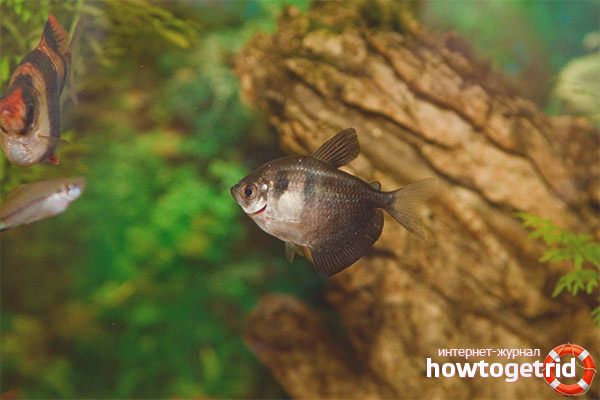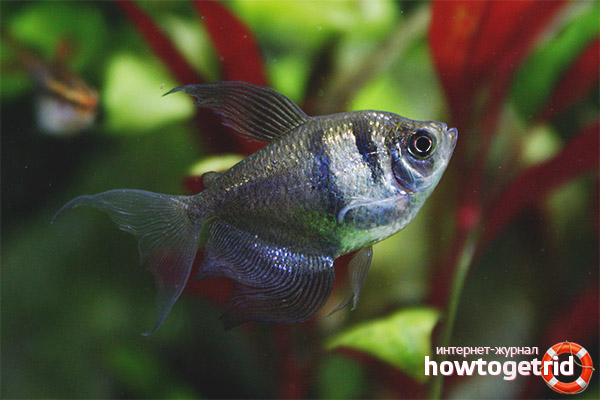The content of the article
Ternetsia or Gymnocorymbus ternetzi - extremely original aquarium fish, which are best suited for those who have little experience in the practice of aquarium. They are hardy, not choosy, not capricious, they are very easy to breed in the home aquarium tanks. They are quite bright and lively, they are distinguished by good activity and vivacity. However, it is undesirable to settle them in the same tank together with other members of the fish family with long fins.
These fish live in flocks and are preferably kept in groups in which there are about 7 individuals. The aquarium should be densely populated with plants, but there should be enough space in it so that the fish can move normally.
In addition to the usual classic look, terntions with veil fins, as well as albinos and caramel, are especially popular. Caramel differs from classical terntions by its brighter coloring, which is appropriated by artificial means. And although the conditions of its maintenance are the same, however, it is more capricious in this regard.
Life in nature
The terns were first described in the 95th year of the 19th century. They are not an endangered species. Their natural habitats are considered to be South America, Paraguay, and also Guaporé. There they live in the upper layers of reservoirs. Individuals of this species in their natural environment feed on larvae and insects that fall to the surface of the water. They like reservoirs with a small current, rivers, streams, tributaries, on which the shadows fall from trees growing on the bank. To date, those terence that are sold to live in aquariums, derived artificially.
Appearance
Their characteristic feature is the presence of two vertical black stripes, which are located on the body in a vertical manner. Also, they have well developed anal and dorsal fins. Lower fin looks like a skirt, which distinguishes this species from other members of the fish family. In adults, the color becomes more pale and it is more gray than black.
Popular types of ternations
Despite the spectacular appearance of classic ternations, today the most popular are species that are distinguished by their originality.
- Caramel Artificially painted aquarium fish of bright and unusual colors. Unfortunately, because of chemistry, they are weaker in terms of health, but they look very impressive.
- Albinos. A rarer species than the classic thorny. But the differences between them and their relatives are few. The only difference in color.
- Veil. First appeared in Europe. They are very common in pet stores.The complexity of the content lies in the breeding of this species, since they are artificially bred by breeding.
Nutrition
Their feeding does not cause any trouble. Ternation feeds on absolutely all available types of food, live, artificial or frozen. The basis of food for them are flakes of good quality. In this case, their diet can be varied with the help of live food, ice cream, for example, bloodworms and artemia.
Content Features
Ternets do not belong to capricious fishes. They are great for those who have not yet experienced aquarium maintenance. They perfectly adjust, eat any food. Suitable for living in shared tanks, but not with individuals that have veil fins.
Thorns - extremely active fish that require a sufficient amount of space in the tanks. The most suitable aquariums from 60 liters. They like soft and sour water. However, their long-term maintenance as aquarium fish led to their being well enough adapted to any conditions.
In an aquarium, you should create conditions as close as possible to those in which the terns live in nature. It is important to plant the tank with large algae floating on the surface; this will make a certain shade, the same as in their natural environment.
By their nature, thorns are “jumping” fish. They very often jump out of aquariums and therefore die. For this reason, care must be taken that the lid is always closed.
Particularly spectacularly, the terntions look in aquariums that are equipped according to the natural biotype with a sandy bottom, an abundance of snags, fallen leaves, which contribute to the acquisition of water of a brownish shade and the necessary level of acidity.
There are no additional requirements in the care of the tank where the terntion is contained. It is worth every week to change the 4th part of the water to fresh, and use the filter. Regarding the parameters of water, ternatii are not picky. However, it is important that they are as follows: pH is from 5.8 to 8.5, the temperature is from 22 to 36 degrees, the acidity is about 20.
Cohabitation with other types of aquarium dwellers
Ternets are quite active fish and sometimes show a little aggressive towards their own kind. For this reason, it is not advisable to keep them together with fish that have large fins.
Their aggression is reduced if they are kept in large flocks. Then they will be more engaged in communication with representatives of their own species. The absolute contraindication is their cohabitation with scalars and cockerels. Small fishes with the same activity, black neon, cardinal, danios, will perfectly suit for the neighborhood with terntions.
Also, for cohabitation with this species, large and predatory fish are categorically contraindicated, which can take advantage of termination for feed.
Gender Differences
The fins are the main difference between male and female fish of ternition. Male representatives of this species have longer and pointed dorsal fins. In females they are fuller, and the hind fin, which looks like a skirt, is wider.
Breeding characteristics
Thorns often multiply in aquarium conditions. They reach sexual maturity at 5-6 months, from now on they can already spawn.After 2 years of age, the fish are not suitable for spawning, they are practically unable to reproduce.
For breeding, it is worthwhile to select the most active individuals between the ages of 1 and 2 years. As for the younger ones, they are also quite suitable for spawning, but from year to year their productivity is higher.
Preferably, the flock for breeding should be resettled in another, small-sized tank with a volume of about 25 liters, and create more comfortable conditions in it that encourage reproduction. In spawning water should be softer and sour, at least 4 dGH. It is preferable to use dark soil and small-leaved plants. Lighting should be more subdued, in any case not bright. If the tank has a bright light, then you can cover it with a piece of paper.
Spawning spawn, as a rule, in the morning. The females lay several honeycombs of sticky caviar on the sheets of algae and decor items. The number of offspring depends on the size of manufacturers. At the end of the spawning season, adults are required to be resettled in a familiar aquarium. This is necessary for the reason that they can simply feast on their own eggs or fry.
How to care for fry?
Caviar of thorns has a surprisingly large size. Its diameter is more than 1 mm. The color of the eggs is yellowish. After spawning, adults with great pleasure eat their eggs. For this reason, they are required as quickly as possible to return to the usual conditions.
If the water temperature is about 28 degrees, then the fry begin to hatch out after about 1.5 days. The process itself is delayed for several hours in time.
Within 4 days they are in the larval phase. After this time, the fry about 7 mm long begin to move inside the tank. As a starter feed, small plankton is used. At this time, it is advisable to settle the fry in a larger aquarium, but not in general. During the first week of life, the fry should be taught to lower water temperatures, and this should be done gradually.
The main rule when growing fry is good nutrition and a spacious aquarium. In such conditions, they quickly reach the size of adults.
Ternetsia is very common and easy to maintain, small-sized aquarium fish. A child of school age may well care for them.They do not require increased attention from the owners and difficult conditions of detention. Their food is also quite simple and, as a rule, consists of the most affordable feed that the owner likes. However, they still require certain conditions that are comfortable for them, especially for breeding purposes.
In no case do you need to keep terntions in the same tank with large predators and charming fish with large and long fins, otherwise such cohabitation may end in a tragic way.
In order to dilute them, you definitely need to get a small separate tank and some patience.
Video: aquarium fish ternitse













To send